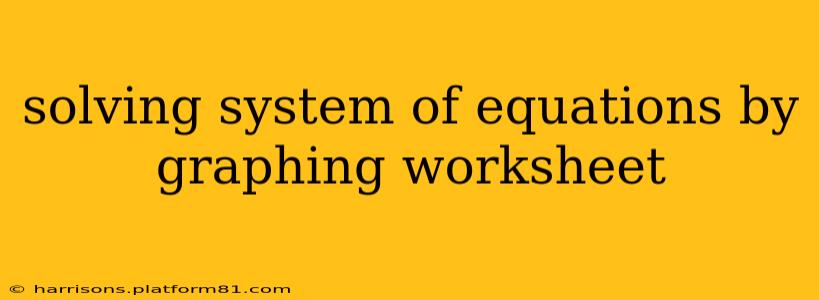Solving systems of equations is a fundamental concept in algebra, with applications spanning various fields. Graphing provides a visual and intuitive method for finding solutions, making it a valuable tool for understanding these systems. This guide will walk you through the process, providing practical examples and addressing common questions.
What is a System of Equations?
A system of equations is a set of two or more equations with the same variables. The solution to the system is the point (or points) where all the equations intersect. For linear equations (equations that form straight lines when graphed), this intersection represents the values of the variables that satisfy all equations simultaneously.
How to Solve Systems of Equations by Graphing
Solving a system of equations by graphing involves three main steps:
-
Graph each equation: Rewrite each equation in slope-intercept form (y = mx + b), where 'm' is the slope and 'b' is the y-intercept. This form makes graphing easier. Plot the y-intercept on the y-axis, then use the slope to find other points on the line.
-
Identify the intersection point: Look for the point where the lines intersect. This point represents the solution to the system.
-
Check your solution: Substitute the x and y coordinates of the intersection point back into both original equations. If the equations hold true, you've found the correct solution.
Example:
Let's solve the system:
- y = x + 2
- y = -x + 4
-
Graphing: The first equation has a slope of 1 and a y-intercept of 2. The second equation has a slope of -1 and a y-intercept of 4. Graph both lines on the same coordinate plane.
-
Intersection: The lines intersect at the point (1, 3).
-
Check:
- Equation 1: 3 = 1 + 2 (True)
- Equation 2: 3 = -1 + 4 (True)
Therefore, the solution to the system is (1, 3).
What if the Lines are Parallel?
What happens when graphing a system of equations reveals parallel lines?
If the lines are parallel, they will never intersect. This means there is no solution to the system of equations. The equations are inconsistent; they represent lines that will never meet.
What if the Lines are the Same?
What if the graphs of the equations in a system are identical?
If the lines are identical (they overlap completely), there are infinitely many solutions. This means any point on the line satisfies both equations. The equations are dependent; one is simply a multiple of the other.
How to Graph Equations with Different Forms?
How do I solve a system of equations when the equations aren't in slope-intercept form?
If your equations aren't in slope-intercept form (y = mx + b), you'll need to rearrange them before graphing. You can use techniques like solving for 'y' or using the x and y intercepts to plot the lines.
What are the Limitations of Solving Systems by Graphing?
Are there any limitations to solving systems of equations using graphing?
While graphing provides a visual understanding, it's not always the most precise method. Estimating the intersection point from a graph can lead to inaccuracies, especially if the intersection isn't at a whole number coordinate. For precise solutions, algebraic methods like substitution or elimination are often preferred.
Conclusion
Graphing provides a valuable visual tool for understanding and solving systems of equations. While it may not always yield perfectly precise answers, its intuitive nature makes it an excellent way to grasp the fundamental concepts involved. Remember to check your solution by substituting the coordinates back into the original equations to ensure accuracy. Practice with various examples, including those with parallel lines and overlapping lines, to master this essential algebraic technique.
